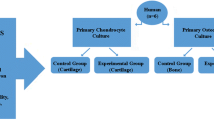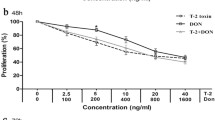Abstract
The potentiation or antagonistic effects of Cu, Hg, Pb and Cd salts in the presence of a long-acting anti-rheumatic drug, D-penicillamine (D.P.) were studied on cultured chondrocytes. CuSO4 (10−4M), HgCl2 (10−5M), Pb(CH3COO)2 (10−3M) and D.P. (10−3M) when used alone caused a small decrease in cell proliferation. The addition of D.P. with Cu, Hg or Pb salts resulted in a marked increase in the extent of growth inhibition. In contrast, CdCl2 (10−5M) produced an important growth inhibitory effect, and D.P. antagonized CdCl2 action. The CuSO4 D.P. toxicity was probably due to production of H2O2 in situ. To verify this hypothesis, catalase, responsible for H2O2 metabolism was used, and was found to partially reverse the inhibitory effect of CuSO4-D.P.
Similar content being viewed by others
References
Aposhian H (1961) Biochemical and pharmacological properties of the metal binding agent penicillamine. Fed. Proc. 20 (3) part II suppl. 10: 185–190.
Bakka A and Digernes V (1984) Effect of cadmium and colcemid on the mitosis of human epithelial cell line with high content cytoplasmic metallothionein. Acta Pharmacol. et Toxicol. 55: 242–246.
Bracken WM, Sharma RP and Kleinschuster SJ (1984) Cadmium accumulation and subcellular distribution in relation to cadmium chloride induced cytotoxicityin vitro. Tox. 33: 92–103.
Evans RM, Patierno SR, Wang DS, Cantoni O and Costa M (1983) Growth inhibition and metallothionein induction in cadmium-resistant cells by essential and non essential metals. Mol. Pharmacol. 24: 77–83.
Friberg L, Piscator M, Nordberg GF and Kiellstrom T (1974) Cadmium in environment. 2nd edn CRC Press, Cleveland.
Green WT (1971) Behavior of articular chondrocytes in cell culture. Clin. Orthop 75: 248–260.
Greenwald RA (1981) Effects of oxygen-derived free radicals on connective tissue macro-molecules: inhibition by copper-penicillamine complex. J. Rheum 8 (suppl. 7): 9–13.
Jaffray P, Ronot X, Adolphe M, Fontagné J and Lechat P (1984) Effect of D-Penicillamine on growth and cell cycle kinetics of cultured rabbit articular chondrocytes. Ann. of Rheum. Disease 43: 333–338.
Kirkpatrick CJ, Korh W and Haferkamp O (1982) Influence of zinc and copper on lapine articular chondrocytes in monolayer culture. Exp. Cell. Biol. 50: 108–114.
Lipsky PE (1984) Immunosuppression by D-Penicillaminein vitro: Inhibition of human T lymphocyte proliferation by copper or ceruleoplasmin-dependent generation of hydrogen peroxide and protection by monocytes. J. Clin. Invest. 73: 53–65.
Lipsky PE and Ziff M (1978) The effect of D-Penicillamine on mitogen-induced human lymphocyte proliferation: synergistic inhibition by D-Penicillamine and copper salts. J. of Immunology 120 (3): 1006–1012.
Mochizuki Y, Kobayashi T and Doi R (1984) Comparison of cytotoxicity of mercury-selenium and mercury compounds on cultured cells. Tox. Letters 22: 47–51.
Priestley GC (1980) Changes in the growth and metabolism of cells cultured from normal, sclerotic and rheumatoid connective tissue brought by D-Penicillamine and by sodium salicylate. J. Invest. Dermatol. 74: 413–417.
Ronot X, Sene C, Boschetti E, Hartmann DG and Adolphe M (1984) Culture of chondrocytes in medium supplemented with calf serum or a serum substitute: Ultroser G. Bio. Cell 51: 307–314.
Staite ND, Messmer RP and Zoschke DC (1985)In vitro production and scavenging of hydrogen peroxide by D-Penicillamine. Arth. and Rheum. 28 (8): 914–921.
Starkebaum G and Root RK (1984) D-Penicillamine: evidence that its immunologic actions can be mediated through copper-catalysed H2O2 generation. Arthritis and Rheum. 4 suppl. 27: S25 No 59.
Walshe JT (1956) Penicillamine, a new oral therapy for Wilson's disease. Am. J. Med. 21: 487–489.
Author information
Authors and Affiliations
Rights and permissions
About this article
Cite this article
Clain, E., Farjaudon, N., Brun, H. et al. Cytotoxicity of D-penicillamine in association with several heavy metals against cultured rabbit articular chondrocytes. Cytotechnology 1, 139–144 (1988). https://doi.org/10.1007/BF00146814
Issue Date:
DOI: https://doi.org/10.1007/BF00146814




